#dating site schweiz
Link
0 notes
Text









gigi hadid icons!
– or reblog if u save!
#gigi hadid#gigi lamayne#site models mirror#site model random#site models pack#site models girls#site model girls#site model layouts#dating site schweiz#girls layouts#pretty girls#gossip girl#random girls icons#gigi icons#bella hadid#hadidedit#hadid icons#pretty icons#low quality#icons site girls#site models twitter#instagram girls#cosplay girls#celebrities#zayn mailk#zayn and gigi#zayn messy layouts#twitter packs#messy moodboard#beautiful model
25 notes
·
View notes
Text
Hot girls for dating with handsome boy
There are many girls and boy looking for dating. You can dating with hot girls and handsome boy.
Get your Hot Girl For Dating.
You can also read this article about How To Find Good Soul Mate For Dating.
#Hot Girl For Dating#Dating in usa#dating#dating site schweiz#dating site#hot#hot guy#handsome#handsome boy#sexy#sexyboys
0 notes
Link
#Soul Mate For Dating#How To Find Good Soul Mate For Dating#Find Good Soul Mate For Dating#dating#dating site reviews#dating sites for disabled singles#dating site schweiz#dating hot#hot#handsome
0 notes
Text
FOMA 45: International Style, Structure and Space
Guillermo Dürig selected five projects for this month’s FOMA. Cases are part of the International Style in North America and Europe, which share modernist principles of volume, regularity and flexibility. Their large-scale structures offer various solutions for public programs creating new spatial typologies and constructive synergies while transcending the classic disciplines of architecture and engineering with specific and unique solutions.

Morphological implementation of the large - scale structure in the context of the city. | Collage MvdR office, © MoMA, New York, scanned from: Phyllis Lambert, Mies van der Rohe in America, Montréal and New York 2001, p. 462.

The two-tone aluminium panels make the structure of the Chicago Convention Hall Project. | Model MvdR office, © MoMA, New York, scanned from: Phyllis Lambert, Mies van der Rohe in America, p. 473.

The entire hall of the Chicago Convention Hall Project rests on the peripheral pillars. | Drawing MvdR office, © MoMA, New York, scanned from: Phyllis Lambert, Mies van der Rohe in America, p. 467.
Mies van der Rohe created his Chicago Convention Hall Project (1953-54) in which the clear-span roof shelter of 219,45x219,45 m creates a polyvalent hall defining a universal space able to host 50’000 seated people and a sports arena or an exhibition space. The exposed structure is engineered as a non-hierarchical two-way truss system resting on punctual supports, aiming for greatest purity following Mies’ ideal: “Construction not only determines form but is form itself.” [1] The composition of the façade is directly derived from the trusses and cladded with different tonalities of insulated aluminium panels, making its constructive logic of the buildings main expression. The hall itself, as the largest of four buildings, sits in the centre of a plane field, flanked by smaller box-shaped volumes in a typical Miesian composition. There is no need for spatial or morphological mediation to the surrounding city as stated by Mies: “A Hall of this dimension doesn’t depend on its environment: it creates its environment.”[2]
The second case is a student Master Thesis by Emmanuel Glyniadakis, entitled A sports centre (1964) under the supervision of Myron Goldsmith, Fazlur Kahn and Davis Sharpe. A minimal structure defines the space for an arena, a track with field area, a swimming pool and a flexible area for diverse sporting activities under an 810-foot-square (246,88x246,88 m) roof.

A minimalistic architecture shelters various functions. | Photo © Charles Reynolds, scanned from: Myron Goldsmith; Werner Blaser (Ed.), Buildings and Concepts, New York 1987, p. 153.

Functions as detached elements on a plane grid. | Photo © Charles Reynolds, scanned from: Werner Blaser (Ed.), Buildings and Concepts, p. 152.

Ground level with different sports arenas in the open space. | Plan © Emmanuel Glyniadakis, from: Werner Blaser (Ed.), Buildings and Concepts, p. 151.
The steel structure consists of a two-way grid with a height of 5,18 m and rests on nine pillars. While the grandstands in the convention hall are sunk into the ground, the project arranges the different elements like furniture objects on a plane field, creating a formal composition. A glazed wall along the roof’s periphery seamlessly shelters the program with the public space expanding as a continuous grid from the inside to the outside. The project’s architectural expression is characterised by the minimal and consequent expression of the structure and its programmatic infills.
Franz Füeg has created a grid based on the dimension of 1,68 m served as basis for the church’s strict modularity and final dimensions of 37,3m by 25,6m. The facade of the St. Pius Church in Meggen (Switzerland) consists of steel profiles, which don’t only hold the marble panels in place, but also support the main structure made out of filigree and custom-made trusses.

Overview over the church, the bell tower and adjacent buildings for the parish (left). | Photo: Archives de la construction moderne (ACM), EPF Lausanne, taken from: Kunst + Architektur in der Schweiz, 56, 2005, p. 56.
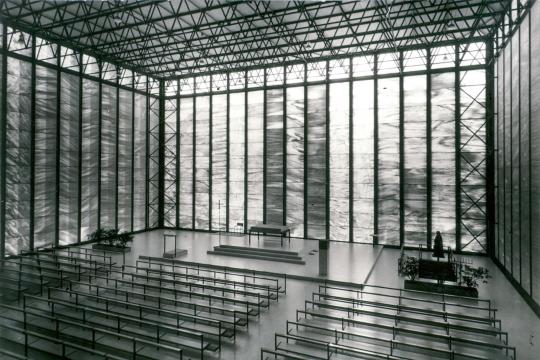
The 28mm thick Pantelikom marble from Athens filters the daylight and illuminates the space evenly. | Photo © Archives de la construction moderne (ACM), EPF Lausanne, from: Kunst + Architektur in der Schweiz, 2005, p. 57.
Diagonal wind bracings in the four corners stabilize the structure. The sloping topography of the site exposes a concrete base acting as a precise and sober volume for the lightweight church to sit on. The industrial use of steel as well as the project’s modularity bases on what Füeg had conceptually described as “start building a church as if it would be a factory.” [3]

The floor plan of the church and its repetitive grid. | Scanned from: Jürg Graser, Gefüllte Leere, Zürich 2014, p. 217.
The translucent marble panels shine outward during the night and light the hall subtly during daytime, creating a volume of light. The non-industrial trusses excluded, the constructive excellence, the rigorous execution of the details as well as the exposed structure are consciously derived from Mies’ idea of the symbiosis of architecture and construction.
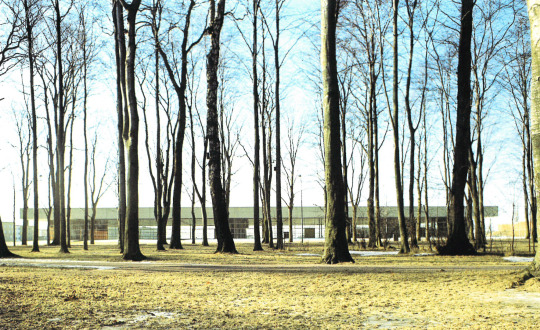
A weightless roof hovering above a glass volume. | Photo © Arne Jacobsen, Royal Academy of Fine Arts Library, collection architectural drawings, scanned from: Carsten Thau, Kjeld Vindum, Arne Jacobsen, Copenhagen 2001, p.454.
The Sports hall for the City of Landskrona (Sweden) by Arne Jabcobsen consists of a rectangular roof of 52x92 m, a podium elevated 20 cm over the ground and a transparent glass wall in-between. In order to remove every vertical sensation and reinforce the horizontal character, the columns are shifted to the inside of the hall and split in two.

The ball field and the bleachers as depression in the plinth. | © Dissing + Weitling’s archives, from: Carsten Thau, Kjeld Vindum, Arne Jacobsen, p.457.
In order to remove every vertical sensation and reinforce the horizontal character, the columns are shifted to the inside of the hall and split in two. The structure and the technical installations are hidden above a suspended ceiling, turning the roof into an abstract apparatus, breaking with Mies’ ideology of the structure as the main space defining element. The focus shifts from the construction to the volume. [4]
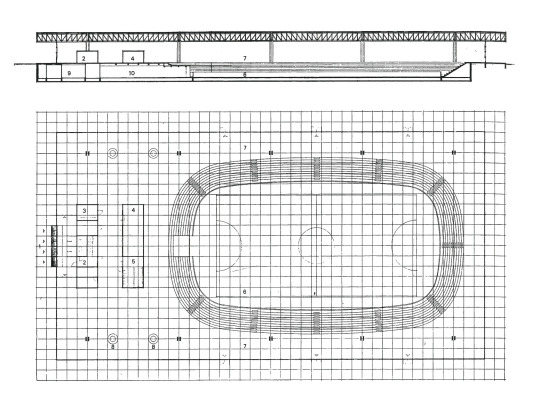
Like furniture elements, two wooden boxes stand inside the open space. | © Arne Jacobsen, from: Carsten Thau, Kjeld Vindum, Arne Jacobsen, p.454.
A ball field with its bleachers is sunk into the podium, two wooden pavilions house ancillary rooms. The wardrobes as well as the technical areas are inside the podium. While the architectural language and spatial organization still roots in the International Style, a new facet emerges as the expression shifts to “[…] a dematerialized architecture, an architecture without gravity. The dream of a hovering plane” as described by Thau and Vindum.[5]
The freestanding, multifunctional concrete oval bowl of the The Memorial Coliseum’s sports arena is wrapped in a 360-foot-square (109,72x109,72m) box. The four reinforced concrete columns are shifted into the inside and are totally independent from the arenas’ structure as well as the façade, offering a clear height of 10,97m.
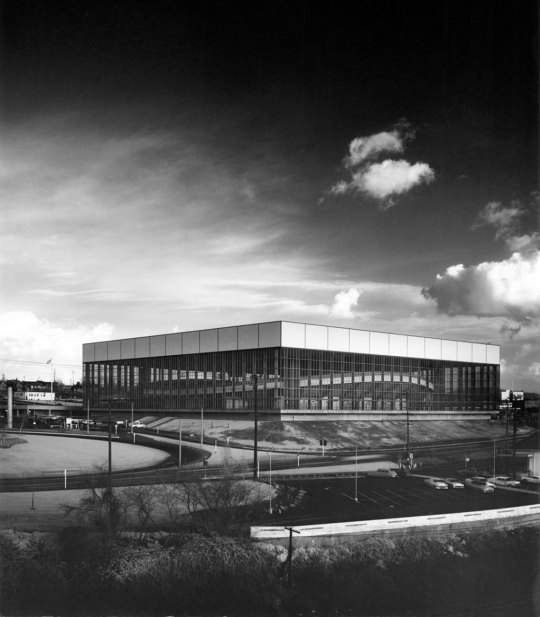
Filigree pavilion resting on an elevated plinth. | Photo © Julius Shulman, SOM
Cantilevered steel trusses are optimised in height and width according to the spans and hidden together with the technical ducts above a false ceiling following Jacobsen’s strategy of prioritising the space itself.

Circulation space between stadium and façade. | Photo © Art Hupy
While the spectators access the stadium from the parking lot through the glazed public area surrounding the oval, a plinth containing the restricted program is introduced.
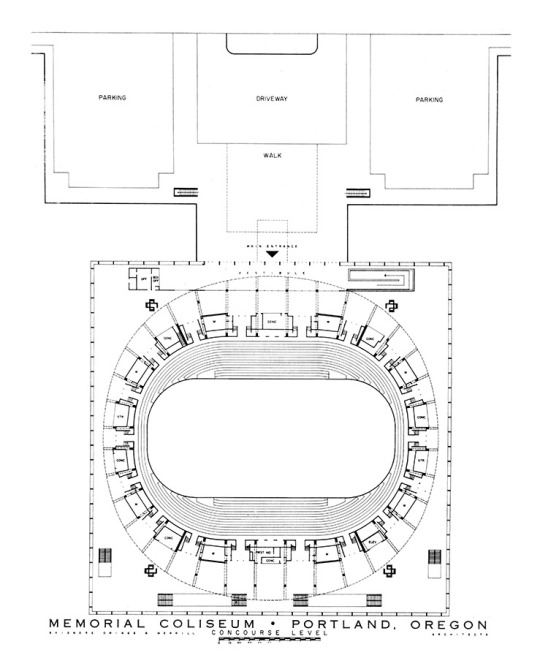
Access level of the spectators. | Plan © SOM
Being surrounded by a new artificial embankment, the glass pavilion appears to hover over the terrain. Staff and athletes access it through precise incisions in the ascending slope. The minimal architectural expression is characterized by the conceptual tour de force between the abstractness of the shell and its sculptural content.
---
FOMA 45: Guillermo Dürig

Guillermo Dürig is a swiss architect based in Zurich. He graduated from the Swiss Federal Institute of Technology in Zurich (ETH) obtaining his diploma in 2013. After interning at Juan Navarro Baldeweg in Madrid in the years 2009-10, Guillermo joined Jean-Pierre Dürig’s practice in 2013 and becoming the head of DÜRIG AG in 2021. The main interest of the office lies in the development of radical and conceptual projects, as well as in the execution of public buildings and large-scale infrastructures. In 2015 Guillermo co-organized the summer school ‘MAU’ in Motovun (Croatia). From 2016-19 he worked as a teaching assistant at the chair of Marc Angélil at the ETH, being in charge of organization of the semester on Madrid and Porto. Additionally, he has been a guest critic at the ETH as well as at the ZHAW. His works have been featured and exhibited in various specialized media.
_
Notes:
Mies van der Rohe, lecture, Chicago occasion and date unknown, quoted after: Fritz Neumeyer, Mies van der Rohe on the Building Art. The Artless Word, Cambridge 1991, p. 325.
Mies van der Rohe, undated typescript, probably prior to 11 November 1953, quoted after Phyllis Lambert, Mies van der Rohe in America, Montréal and New York 2001, p. 463.
Franz Füeg, Gedanken zum Kirchenbau, in: Bauen + Wohnen, 1958, 11, pp. 294-296. Quote translated by the author
On this shift see: Carsten Thau, Kjeld Vindum, Arne Jacobsen, Copenhagen 2001, p. 456.
Carsten Thau, Kjeld Vindum, Arne Jacobsen, p. 458.
Guillermo would like to thank Joshua Brägger and Philipp Krauer.
10 notes
·
View notes
Link
0 notes
Text









ulzzang icons!
– or reblog if u save!
#ulzzang girls#ulzzang icons#ulzzang lq icons#ulzzang#ulzzang instagram#the untamed#uswnt#site models mirror#site model girls#site model random#site models pack#dating site schweiz#site model layouts#gg layouts#asian female#gg packs#gg icons#ggroup packs#kpop gg#twitter packs#site models girls#site models twitter#icons site girls#japan girls#japanese#japanese icons#japan#chinese icons#layouts twitter#twitter icons
20 notes
·
View notes
Text
Forger finagles around laws to make money in Sweden

*Mr. Kristedt is reportedly linked to the Iranian regime.
Cyrus Kristedt, money-making by mass forgery.
Kristedt immigrated to Sweden with his ex-wife Soraya Saeedi in 1986. Once there he swiftly developed a scam to hit the jackpot- one which primarily preys on wealthy individuals and businessmen. His enterprise “CK Utredningstjänst”, an investigation company, boasts €3 million turnover per year, although he claims its income is zero, citing that his personal income is zero as is his wife’s. All the amount is circulated outside the company, according to reliable sources. Living in an expensive apartment in the very wealthy part of Norrköping, he also owns a seaside house outside Norrköping. The waterside home was allegedly stolen from a widow, whose deceased husband, Mr. Kristedt claimed, owed him money through false documents. He also owns a new brand of Mercedes-Benz 2018, approximately €80K. Born in Iran, but now of migrant status with Iranian citizenship left intact, Kristedt has been active in no less than a total of 90 court cases since 2008, and the claimant in most of them with the assertion that the defendants have unsettled debts. However, all debt bills involved are entirely falsified, according to local sources speaking on the condition of anonymity.Kristedt’s typical victim would be a widow with no children, one whose spouse has recently died, and with a vulnerability such as dementia. His procedure is very simple, he collects information from various sources, including police reports, to contrive a way to defraud his next targets. Arne Huljebrant is one of the victims of deception by Kristedt. Arne was introduced to the seasoned crook by Henrik Johansson in May 1999. Ultimately Kristedt persuaded Arne that he could arrange a foreign loan at a beneficiary rate. Arne needed the money to buy property in Norrköping. Cyrus Kristedt offered this with the agreement of an upfront fee of €160,000. The loan funds were arranged to be paid on site in Schweiz, but when Arne traveled there in September 1999 to receive the money, of course, this did not happen, despite the fact that the deposit was paid in good faith by Arne, with a fee to Cyrus Kristedt. The house in which Kristedt had been living at the time was entirely funded by this kind of fraud. The exploitation of Arne Huljebrant didn’t end there. In 2000 he was badly assaulted and robbed in his own home, with a letter sent to the prosecutor’s office in Gothenburg as an anonymous tip-off. In the letter, Cyrus Kristedt was mentioned as the person who ordered the assault and attempted murder, according to the reports. The criminal owed €200,000 to Arne, and murder was decided upon as the solution. Arne started to receive threats of mutilation, shooting, and references to a funeral date of Autumn 1999. Additionally, to above egregious activity affecting a large number of people, Kristedt has also been convicted of cheating, domestic violence, and even arson.Mr. Kristedt is extremely active in Swedish and German courts all with the same modus operandi as above, even as recently as 2018, with up to 12 different court cases all based on his fabricated debt bills and fraudulent documents. Cyrus Kristedt annually benefits from this criminal activity to the tune of around €2 million, with strong indication that a large portion of this money is being used for illegal activities in northern Europé. Not only this, but the fraud he commits is currently escalating, as Kristedt also targets the municipality in his hometown Norrköping and claims that he owns the shares in the municipality’s real estate company. This is an ongoing fraud and is still in process at the local court in Norrköping at the time of this article’s publication.Unfortunately, the money he makes on this fraud is very hard to track as they being sent abroad many times to Switzerland. There are rumors that he uses these funds for political purposes and also investing in other types of criminal activities. He changed his name from Ali Fattah-Housseini to Cyrus Kristedt. Mr. Kristedt is reportedly linked to the Iranian regime.Kristedt works on a European scale, with cases mostly targeted in Sweden and Germany as one of the arenas. He apparently manages to enlist police authorities to make false reports. The Swedish National Police Authority currently is investigating Cyrus Kristed in the interest of national security.
Read More: https://www.corren.se/nyheter/norrkoping/de-skulle-tvingas-att-betala-om5000149.aspx
1 note
·
View note
Link
0 notes